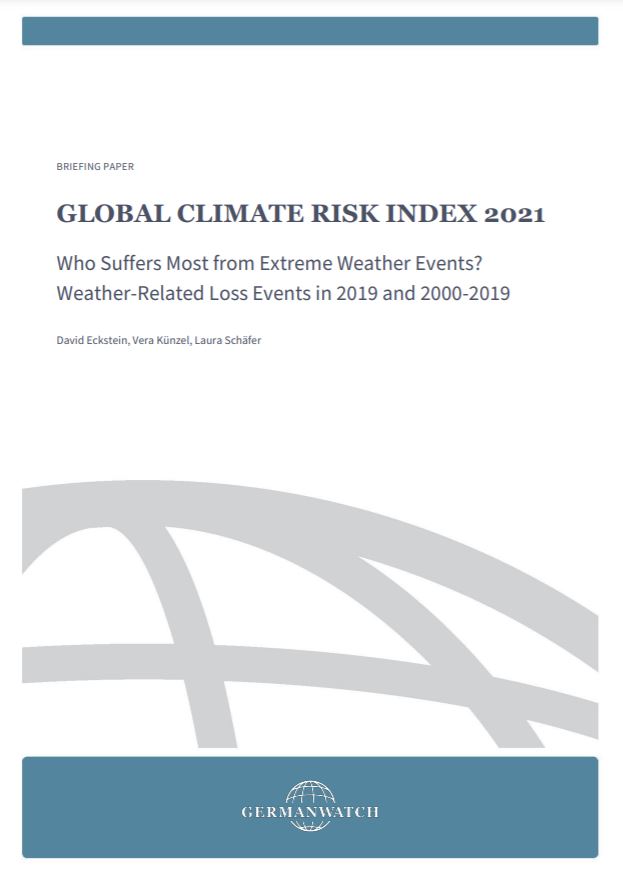
February 19, 2021 Friday

Access the full results of the Global Climate Risk Index 2021 by visiting the website of Germanwatch at https://germanwatch.org/sites/germanwatch.org/files/Global%20Climate%20Risk%20Index%202021_1.pdf.
MANILA, 20 February 2021 — The Climate Change Commission (CCC) renews the call to strengthen the country’s disaster risk reduction planning through science to reduce the irreversible impacts of climate change and to mitigate damage from floods, typhoons, and other disasters.
In a bulletin issued today by the Philippine Atmospheric, Geophysical, and Astronomical Services Administration (PAGASA), Tropical Storm Auring was estimated at 595 km East Southeast of Hinatuan, Surigao del Sur with maximum sustained winds of 75 km/h near the center and moving eastward at 15 km/h. Despite slight weakening, PAGASA warned that Auring could still bring heavy to intense rain, floods, and landslides to several areas in the Visayas and Mindanao.
Residents in flood-prone and landslide prone areas are advised to monitor the weather bulletins and take appropriate action should flooding occur as Auring is expected to stay within the Philippine Area of Responsibility until Tuesday.
Just this week, parts of Davao were severely affected by widespread flood due to local thunderstorms, displacing more than thousands of families and brought massive damage to agriculture and infrastructure.
With this, the CCC stresses the importance of disaster preparedness and risk management as the country remains one of the most affected by extreme weather events due to climate change over the past two decades.
The Philippines was ranked fourth among countries most affected by extreme weather events from 2000-2019, according to Global Climate Risk Index 2021 by Germanwatch. The ranking is said to be attributed to the aftermath of devastating typhoons over the last decades, including Typhoon Ondoy (2009), Typhoon Pablo (2012), Super Typhoon Yolanda (2013), and Typhoon Ompong (2018), which were responsible for the loss of thousands of lives, as well as the massive damage to agriculture and infrastructure. Another factor is the long process of recovering from the previous year’s impacts. Overall, 317 extreme weather events were recorded in the country from the 20-year period, the highest among the top 10 countries on the report.
Philippines, along with Haiti and Pakistan, is continuously ranked among the most affected countries both in the long-term index and in the index for the respective year.
The Global Climate Risk Index yearly analyzes and ranks to what extent countries and regions have been affected by impacts of climate-related extreme weather events, which include storms, floods, and heatwaves, among others. It also indicates a level of exposure and vulnerability to these extreme weather events which countries should understand as warnings in order to be prepared for more frequent and/or more severe events in the future.
With this report, the CCC underscored the need to identify gaps within the systems in mainstreaming disaster risk reduction and climate change adaptation in the development, investment, and land use planning processes.
The major factors that led to severe damage to the communities due to these extreme typhoons include excessive rainfall due to climate change; improper land uses, which include the construction of settlements and cultivation in flood-prone areas; siltation of waterways due to excessive soil erosion because of illegal logging and deforestation; and poor or non-implementation of the solid waste management policies on the local level.
As one of the countries most vulnerable to climate hazards, the Commission also called on the developed countries to accelerate and scale up the support to the country in areas of finance, green technology, and capacity development in order to build resilience against typhoons and other climate impacts.
Lastly, the CCC said that stronger policy measures must be formulated to help avert future loss and damage and ensure sustainable and resilient recovery in light of the escalating climate-related disaster risks compounded by factors caused by the COVID-19 pandemic.